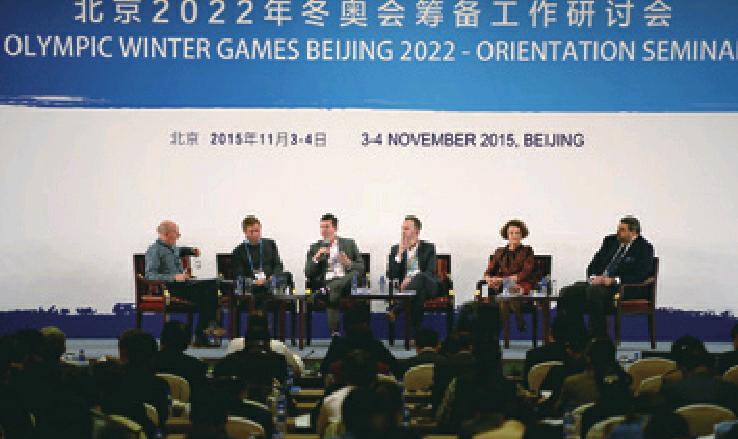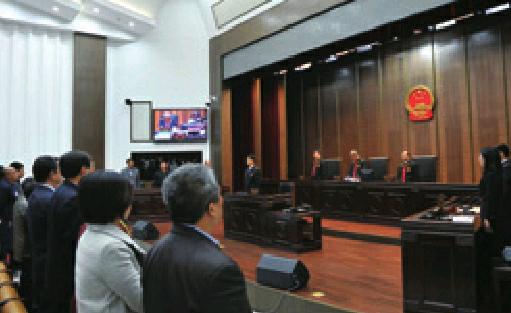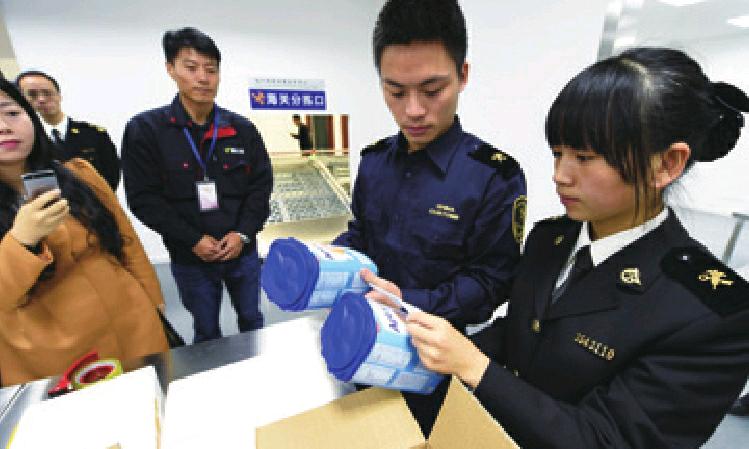Olympics Preparation
2015-12-07
Members of an International Olympic Committee (IOC) delegation attend a two-day Orientation Seminar with the Beijing 2022 Olympic Winter Games organizers in Beijing on November 3.
It was the first IOC meeting with the 2022 team since Beijing won the right to host the Games in August.
Historic Meeting
Xi Jinping and Ma Ying-jeou, in their capacity as “leaders of the two sides” of the Taiwan Straits, would meet in Singapore on November 7 to exchange views on promoting peaceful development of cross-Straits relations and discuss major issues in deepening cooperation in the region and improving peoples welfare, the minister of the Taiwan Affairs Office of the State Council announced in Beijing on November 4.
In line with the one-China principle, the Chinese mainland and Taiwan reached the pragmatic arrangement, showing their willingness to push aside their differences while respecting one another, said Zhang Zhijun, who is also head of the Taiwan Work Office of the Communist Party of China (CPC) Central Committee.
He added that the meeting will“create new space” for ties and lift crossStraits exchanges and interaction to a new level.
The Kuomintang, Taiwans ruling party, said in an online statement that the meeting will be “a major watershed”for the two sides to realize mutually beneficial cooperation.
Green Fund
China will establish the Green Development Fund to promote clean production and sustainable growth, according to a document issued by the CPC on November 3.
China will steer traditional manufacturing toward an environmentfriendly path, establish a low-carbon circular production system and encourage businesses to upgrade their technology, according to proposals released by the CPC Central Committee on formulating the 13th Five-Year Plan(2016-20) for national economic and social development.
The document was adopted at the Fifth Plenary Session of the 18th CPC Central Committee, which ended on October 29.
China will encourage low-carbon development by promoting clean energy, green transport, controlling carbon emissions in major industries and boosting the circular economy, the document said.
Less Pollution
Beijings environment authority said on November 2 that the citys PM2.5 density, an indicator of air pollution, has dropped by over 20 percent during the first 10 months of the year from the same period of last year.
The average density of PM2.5, airborne particles smaller than 2.5 microns in diameter, was 69.7 micrograms per cubic meters in Beijing, down 21.8 percent year on year. Meanwhile, the density of PM10, sulfur dioxide, and nitrogen dioxide fell by 21 percent, 39.8 percent and 17.1 percent, respectively, according to the Beijing Environmental Protection Bureau.
During the first nine months, Beijings number of days with good air quality grew by 31 from last year, and the number of days with heavy pollution dropped by 16.
The bureau attributed the improvement to air pollution control measures and favorable weather conditions.
The city removed some 280,000 old cars from roads, closed 315 polluting companies, and increased green areas by 6,000 hectares during the first 10 months.
Recording History
The Comprehensive History of Tibet compiled by Chinas official academic institute was published on October 30.
With eight volumes and more than 9 million Chinese characters, it is the first book introducing the comprehensive history of Tibet in a systematic way, according to Editor in Chief Lhapa Phuntsog.
“The book is conducive to inheriting and developing excellent national cultural traditions, as well as cultivating the awareness of the Chinese national community and serving the stability and development of Tibet,” he said at a premiere event.
The China Tibetology Research Center led the compilation work as a state-level key project.
‘Chinese Corners
A total of 50 overseas “Chinese corners”have been set up in 50 libraries in 35 countries worldwide, the headquarters of Chinas Confucius Institute said on November 3.
According to China Educational Publication Import & Export Corp., which helps establish the language study, 20 of the 35 “Chinese corners”are in countries along the Silk Road Economic Belt and the 21st-Century Maritime Silk Road proposed by China. Many have been operating for over a year.
Zhu Hongtao, general manager of the company, said that “Chinese corners” have become a display window for refined Chinese textbooks and publications and a platform for foreign Chinese fans to learn and communicate.
World-Record Robot
A quadruped robot in the southwestern municipality of Chongqing walked its way on to the pages of the Guinness World Records book on November 1.
Xingzhe No.1 was developed by Li Qingdu, a professor at Chongqing University of Post and Telecommunications College of Automation. Starting on October 24, it took 340,000 continuous steps over 54 hours, covering a distance of 134.03 km and using 0.8 kwh of power.
The previous record was set by Ranger, a quadruped robot developed by Cornell University in the United States, which walked 65 km in 30 hours consuming 0.5 kwh of power.
Li and his team began developing the robot in November 2014. The first prototype was produced in January.
Model for Mars
Working staff install a Mars probe model before the 17th China International Industry Fair kicked off in Shanghai on November 3.
The golden model, which is a third of its real size, consists of an orbiter and a lander.
Oil Spill Case
A court in Tianjin on October 30 orders American oil giant Conoco Phillips to pay 1.68 million yuan ($265,000) to 21 fishermen, who claimed their fishing interests and livelihood were severely damaged by the 2011 Bohai Bay oil spill.
The accident involved a subsidiary of Conoco Phillips in China.
It is the first case brought by a social organization over maritime pollution since China changed its law to allow registered non-profit organizations, which have been dealing with environmental issues for at least five years, to sue heavy polluters.
Expedition Vehicle
Chinas first all-terrain vehicle to work in polar conditions will join the countrys 32nd Antarctic expedition that set off on November 7.
The vehicle, developed by the Polar Research Institute of China and Guizhou Jonyang Kinetics Co. Ltd., was delivered to the expedition team in Shanghai on November 4.
The amphibious vehicle has excellent maneuverability and can run in snowfields, deserts, beaches and mountainous regions at a maximum speed of 60 km per hour and 5 km per hour in water, said Lyu Qian, President of Guizhou Jonyang Kinetics.
It can also cross 0.6-meter vertical barriers and 1.5-meter ditches and work in environments between negative 41 degrees and 40 degrees Celsius, said Lyu.
The vehicle is equipped with a low-carbon-emission engine and a computer system that can transmit operation data from the Antarctic back to China for analysis, he added.
A Lower Target
Chinese President Xi Jinping said on November 3 that China needs its economy to grow at a rate of at least 6.5 percent in the coming years to become“moderately prosperous.”The statements were made following the Fifth Plenary Session of the 18th CPC Central Committee held on October 26-29, at which Party leaders promised to make the worlds second largest economy more productive and to raise peoples living standards.
GDP growth of “no less than 6.5 percent” is required to achieve the Partys goal of doubling the economys size by 2020 from its 2010 level, President Xi said. It is the latest indication that the Party might reduce its official GDP growth target, which has been fixed at 7 percent since 2011. Last years figure was 7.4 percent, while this year it is expected to come in at just below 7 percent.
“In the next five years, Chinas development should not just be focused on growth pace, but also growth volume, and, more importantly, growth quality.”
The service sectors GDP contribution will continue to rise, while domestic consumption will play a much larger role as China aims to become an innovation-driven country with a more talented workforce.
It will take time to eliminate excessive production capacity, optimize the economic structure and achieve innovation-driven development, President Xi said. As a result, it will not be easy to maintain relatively fast growth.
Chinas economy grew by 6.9 percent in this years third quarter, its slowest quarterly rate in six years.
Far From Germany
Local customs officials examine milk powder imported from Germany in Fuzhou, capital of southeast Chinas Fujian Province, on November 3.
That day, cross-border e-commerce businesses started operating in Fuzhou sub-zone of the China (Fujian) Pilot Free Trade Zone, which was inaugurated in April.
October PMI
Official data show Chinas factory activity held steady in October as the countrys manufacturing sector saw improved but still weak demand.
The manufacturing purchasing managers index (PMI) came in at 49.8 in October—the same pace as September—lagging market expectations of 50.0, according to data released on November 1 by the National Bureau of Statistics and the China Federation of Logistics and Purchasing.
A reading above 50 points indicates an expansion in activity on a monthly basis, while one below that points to a contraction.
Growth in the countrys services industry cooled, as the PMI for the nonmanufacturing sector fell to 53.1 in October, a 0.3-percentage-point down from September. The activity reading, while still robust, is the lowest since 2009.
Non-manufacturing PMI tracks business activities in the service and construction industries.
JD-Alibaba Row
JD.com Inc., Chinas second largest ecommerce site, filed a complaint to industry authorities claiming that its rival Alibaba Group Holding Ltd. was disrupting the market order.
In a complaint filed on November 3 to the State Administration of Industry and Commerce (SAIC), the Beijingbased company said Alibaba told retailers to pick a side in the upcoming Singles Day, Chinas largest online shopping festival, which falls on November 11 each year.
“Alibaba conveyed a message to retailers that if they participated in its Tmall promotion campaign on the Singles Day, they will not be allowed to attend similar events held by rival sites,”JD said in a statement.
Alibaba threatened to direct less traffic to retailers who were unwilling to follow its demands, JD claimed, adding“such behavior poses barriers to market competition and severely undermines consumers interests.”
In response, Alibaba said it lets consumers decide which platforms they are willing to choose.
JD.com said SAIC had accepted the complaint and was looking into the matter. The SAIC has not yet commented on the issue.
Robotic Production
A visitor views an assembly line operated solely by robots at the China International Industry Fair, which opened in Shanghai on November 3.
The five-day fair, with themes of innovation, intelligence and green development, attracted over 2,200 companies to exhibit their latest industrial technologies.
SOE Reform
The State Council unveiled guidelines for reforming the management of the countrys colossal state-owned assets.
The guidelines, released on November 4, specified plans to establish an investment firm to manage the states capital and restructure stateowned enterprises (SOEs). It was a supporting document for a previous State Council guideline released in September on advancing SOE reform.
China will set up a firm in charge of capital investment and operations by either transferring state equities and budgets to a new company or by transforming a qualified wholly state-owned enterprise that already exists, according to the guidelines.
The firm can increase the value of state capital by managing equity, management staff and fund movements or optimizing layout through investment and financing, industrial support and capital integration.
The country will also accelerate its elimination of outdated and excessive SOE capacity and dispose of inefficient assets. State capital will be removed from some SOEs, while others will be restructured or upgraded based on innovation.
The newly distributed capital will be concentrated in key sectors, major infrastructure, forward-looking and strategic industries, key areas in the industrial chain, and firms with strong competitiveness.
In the process of establishing the investment firm and restructuring SOEs, the government will transfer some state equities into the hands of social security funds, so that proceeds from those equities can be used to make up for a shortfall in pension funds, according to the guidelines.
The restructuring of unprofitable SOEs will free up the current constraints on non-business operations, such as schools and hospitals, to enhance industrial profits.
The State Council meeting also decided to speed up the restructuring of“zombie enterprises” to encourage the market-oriented allocation of resources.“Zombie enterprises” generally refer to unprofitable businesses, which could be companies burdened by debt, mismanagement or overcapacity.
EV Roadmap
Details on a new energy vehicles roadmap under the Made in China 2025 strategy were unveiled to Chinese media on November 2.
It has been reported that the annual sales volume of Chinas new-energy vehicles will reach 20 percent of total demand in the automobile market up to 2025.
Annual sales volume of self-owned new energy vehicles is set to exceed 1 million.
In line with the new plan, independent new energy vehicles will have more than 80 percent of the market share.
The government will encourage innovation and a new-energy vehicle development plan linked with other industries to achieve this goal.
Cross-Border Payment
Lakala, Chinas largest Internet finance and community e-commerce company, has signed an agreement with Britains largest bill payment service company, it announced on November 4.
Lakala and Allpay Ltd. will establish a cross-border financial service platform and create community convenience services, smart wearable devices and cross-border e-commerce, according to Lakala Chairman and President Sun Taoran.
The company will export some of its payment hardware devices and software to Europe because, as Sun observed, China is a leading player in the Internet finance market.
Lakalas cross-border payment service covers over 20 currencies and the majority market in Asia and now is making forays into the European and North American markets.
